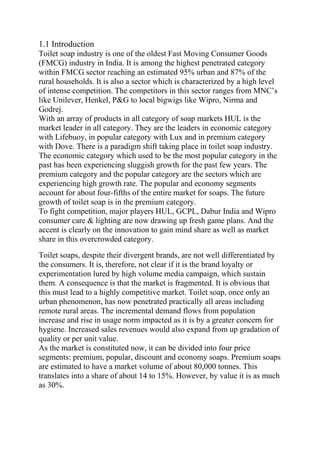Report
- 1. 1.1 Introduction<br />Toilet soap industry is one of the oldest Fast Moving Consumer Goods (FMCG) industry in India. It is among the highest penetrated category within FMCG sector reaching an estimated 95% urban and 87% of the rural households. It is also a sector which is characterized by a high level of intense competition. The competitors in this sector ranges from MNC’s like Unilever, Henkel, P&G to local bigwigs like Wipro, Nirma and Godrej.<br />With an array of products in all category of soap markets HUL is the<br />market leader in all category. They are the leaders in economic category with Lifebuoy, in popular category with Lux and in premium category with Dove. There is a paradigm shift taking place in toilet soap industry.<br />The economic category which used to be the most popular category in the past has been experiencing sluggish growth for the past few years. The premium category and the popular category are the sectors which are experiencing high growth rate. The popular and economy segments account for about four-fifths of the entire market for soaps. The future growth of toilet soap is in the premium category.<br />To fight competition, major players HUL, GCPL, Dabur India and Wipro consumer care & lighting are now drawing up fresh game plans. And the accent is clearly on the innovation to gain mind share as well as market share in this overcrowded category.<br />Toilet soaps, despite their divergent brands, are not well differentiated by the consumers. It is, therefore, not clear if it is the brand loyalty or experimentation lured by high volume media campaign, which sustain them. A consequence is that the market is fragmented. It is obvious that this must lead to a highly competitive market. Toilet soap, once only an urban phenomenon, has now penetrated practically all areas including remote rural areas. The incremental demand flows from population increase and rise in usage norm impacted as it is by a greater concern for hygiene. Increased sales revenues would also expand from up gradation of<br />quality or per unit value. <br />As the market is constituted now, it can be divided into four price<br />segments: premium, popular, discount and economy soaps. Premium soaps are estimated to have a market volume of about 80,000 tonnes. This translates into a share of about 14 to 15%. However, by value it is as much as 30%.<br />Soaps are also categorized into men's soaps, ladies' soaps and common soaps. There are a few specialty soaps as transparent Glycerine soaps, sandal soaps, specially flavoured soaps, medicated soaps and baby soaps.<br />Specialty soaps are high valued but enjoy only a small share of the market in value terms.<br />The market is growing at 7% a year. This means that the incremental demand generation is 5% over and above the population growth. With increasing awareness of hygienic standards, the market could grow at a rate higher than 8% annually. Interestingly, 60% of the market is now sourced from the rural sector. This means that the variance between the two segments is not very large. Since upper-end market focus is the urban<br />areas, margins come from the urban sector.<br />


